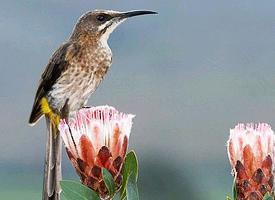
Váhy a míry
| Délka | od 25 do 44 cm |
|---|
Popis zvířete
The Cape sugarbird (Promerops cafer) is a striking and unique species of bird that is native to the fynbos region of South Africa. This bird is particularly known for its elongated tail feathers and its intricate relationship with the flora of its habitat, making it an emblematic species of the Cape floral kingdom. The Cape sugarbird plays a critical role in the pollination of various plant species, including the iconic protea, upon which it heavily relies for food.Adult Cape sugarbirds are medium-sized birds, with males being noticeably larger than females, especially in terms of their tail length. Males can reach up to 44 cm in length, much of which is accounted for by their spectacular tail feathers that can be twice the length of their body. Females, while also possessing long tails, are generally shorter, with their overall length reaching up to 25 cm. Both sexes exhibit a predominantly brownish-grey plumage, with males displaying a distinctive metallic green throat patch that adds to their allure. The underparts of these birds are paler, often with a whitish appearance, and their wings exhibit a subtle iridescence in sunlight.
One of the most fascinating aspects of the Cape sugarbird is its feeding behavior. Equipped with a long, curved beak perfectly adapted for nectar feeding, this bird skillfully maneuvers among the flowers of the fynbos, sipping nectar while hovering or perching. Its diet, however, is not limited to nectar; Cape sugarbirds also consume insects, which they often catch in flight, adding essential proteins to their diet. This dietary flexibility allows them to thrive in their native habitats throughout the year.
Breeding season for the Cape sugarbird brings about another layer of their intriguing behavior. Males become fiercely territorial, engaging in aerial displays and vocalizations to attract females and defend their territory. Their long tails play a crucial role in these displays, with longer tails often correlating with higher attractiveness to potential mates. Nests are constructed by females using fine plant materials, and are usually placed in the dense foliage of shrubs or trees. The female lays 1 to 3 eggs, which she incubates alone, while the male continues to guard the territory against intruders.
The Cape sugarbird's habitat is closely tied to the presence of flowering plants, especially proteas, in the fynbos biome. This relationship highlights the importance of biodiversity and the interconnectedness of species within ecosystems. Unfortunately, the Cape sugarbird faces threats from habitat destruction, mainly due to agricultural expansion, urban development, and the spread of invasive plant species. Climate change also poses a significant threat, potentially altering the distribution of the fynbos vegetation and affecting the bird's food sources.
Conservation efforts are crucial to ensure the survival of the Cape sugarbird and the unique biodiversity of the fynbos region. Protecting their habitat, managing invasive species, and supporting sustainable agricultural practices are key strategies in preserving this remarkable bird and its environment. The Cape sugarbird, with its distinctive appearance and ecological role, stands as a symbol of the natural beauty and complexity of the South African fynbos, reminding us of the importance of conserving our planet's unique habitats and species.
Nové fotografie zvířat
Top 10 zvířat
- Chinese water dragon (Physignathus cocincinus)
- Galápagos tortoise (Geochelone nigra complex)
- Dolphin gull (Leucophaeus scoresbii)
- Japanese macaque (Macaca fuscata)
- Colombian red howler (Alouatta seniculus)
- Sea urchins (Echinoidea)
- Diana monkey (Cercopithecus diana)
- Moustached guenon (Cercopithecus cephus)
- Colossal squid (Mesonychoteuthis hamiltoni)
- Common house mosquito (Culex pipiens)